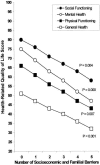Health-related quality of life in urban African Americans with type 2 diabetes
- PMID: 12133154
- PMCID: PMC1495053
- DOI: 10.1046/j.1525-1497.2002.11002.x
Health-related quality of life in urban African Americans with type 2 diabetes
Abstract
Objective: To examine the association of socioeconomic barriers, familial barriers, and clinical variables with health-related quality of life (HRQL).
Methods: A cross-sectional study was conducted of 186 African Americans with type 2 diabetes recruited from 2 primary care clinics in East Baltimore, Maryland. Physical functioning, social functioning, mental health, and general health were measured using the Medical Outcomes Study 36-item short form. Socioeconomic (money, housing, street crime) and familial (family problems, caretaker responsibilities) barriers were assessed by standardized interview. Insulin use, comorbid disease, and measured abnormalities in body mass index, hemoglobin A1c (HbA1c), blood pressure, lipids, and renal function were investigated.
Results: Mean HRQL scores were: physical functioning, 61 +/- 29; social functioning, 76 +/- 26; mental health, 69 +/- 21; and general health, 48 +/- 21. Linear regression analyses revealed that each barrier to care was significantly associated with lower scores in 1 or more HRQL domain. As number of socioeconomic and familial barriers increased from 0 to 5, HRQL scores decreased by 18 for social functioning, 21 for general health, 23 for physical functioning, and 28 for mental health (all P for trend <.01). Clinical variables significantly associated with reduced HRQL were obesity, impaired renal function, insulin use, and comorbid disease. Blood pressure, lipids, and HbA1c were not significantly associated with HRQL.
Conclusions: An independent, graded relationship was found between socioeconomic and familial barriers to care and HRQL. This relationship was at least as strong as the association between HRQL and the clinical variables more likely to be perceived by participants as causing symptomatic distress or impacting lifestyle.
Figures

Similar articles
-
Health-related quality of life in children and adolescents who have a diagnosis of attention-deficit/hyperactivity disorder.Pediatrics. 2004 Nov;114(5):e541-7. doi: 10.1542/peds.2004-0844. Pediatrics. 2004. PMID: 15520087
-
Cross-sectional study of health-related quality of life in African Americans with chronic renal insufficiency: the African American Study of Kidney Disease and Hypertension Trial.Am J Kidney Dis. 2002 Mar;39(3):513-24. doi: 10.1053/ajkd.2002.31401. Am J Kidney Dis. 2002. PMID: 11877570
-
Health-related quality of life in a randomised placebo-controlled trial of sibutramine in obese patients with type II diabetes.Int J Obes Relat Metab Disord. 2004 Apr;28(4):600-5. doi: 10.1038/sj.ijo.0802591. Int J Obes Relat Metab Disord. 2004. PMID: 14770192 Clinical Trial.
-
Health-related quality of life in a binational population with diabetes at the Texas-Mexico border.Rev Panam Salud Publica. 2008 Mar;23(3):154-63. doi: 10.1590/s1020-49892008000300002. Rev Panam Salud Publica. 2008. PMID: 18397581
-
The relationship between health-related quality of life, perceived social support, and social network size in African Americans with aphasia: a cross-sectional study.Top Stroke Rehabil. 2022 Apr;29(3):230-239. doi: 10.1080/10749357.2021.1911749. Epub 2021 Apr 18. Top Stroke Rehabil. 2022. PMID: 33866954
Cited by
-
Religion, spirituality, coping, and resilience among African Americans with diabetes.J Relig Spiritual Soc Work. 2019;38(1):93-114. doi: 10.1080/15426432.2018.1524735. Epub 2018 Oct 25. J Relig Spiritual Soc Work. 2019. PMID: 31607831 Free PMC article.
-
Effect of problem-solving-based diabetes self-management training on diabetes control in a low income patient sample.J Gen Intern Med. 2011 Sep;26(9):972-8. doi: 10.1007/s11606-011-1689-6. Epub 2011 Mar 29. J Gen Intern Med. 2011. PMID: 21445680 Free PMC article. Clinical Trial.
-
Influences of Demographic, Social Determinants, Clinical, Knowledge, and Self-Care Factors on Quality of Life in Adults With Type 2 Diabetes: Black-White Differences.J Racial Ethn Health Disparities. 2022 Aug;9(4):1172-1183. doi: 10.1007/s40615-021-01058-9. Epub 2021 May 19. J Racial Ethn Health Disparities. 2022. PMID: 34009560 Free PMC article.
-
Project HEAL: peer education leads to weight loss in Harlem.J Health Care Poor Underserved. 2008 Feb;19(1):180-92. doi: 10.1353/hpu.2008.0016. J Health Care Poor Underserved. 2008. PMID: 18263994 Free PMC article.
-
Individual-, Community-, and Health System-Level Barriers to Optimal Type 2 Diabetes Care for Inner-City African Americans: An Integrative Review and Model Development.Diabetes Educ. 2020 Feb;46(1):11-27. doi: 10.1177/0145721719889338. Epub 2019 Dec 5. Diabetes Educ. 2020. PMID: 31802703 Free PMC article.
References
-
- Tull ES, Roseman JM. Diabetes in African Americans. In: National Diabetes Data Group, ed. Diabetes in America. Bethesda, Md: National Institute of Diabetes and Digestive and Kidney Diseases, National Institutes of Health; 1995. pp. 613–30.
-
- McDowell I, Newell C. Measuring Health: A Guide to Rating Scales and Questionnaires. 2nd ed. New York: Oxford University Press; 1996.
-
- Rubin RR, Peyrot M. Quality of life and diabetes. Diabetes Metab Res Rev. 1999;15:205–18. - PubMed
-
- Gary TL, Crum RM, Cooper-Patrick L, Ford D, Brancati FL. Depressive symptoms and metabolic control in African-Americans with type 2 diabetes. Diabetes Care. 2000;23:23–9. - PubMed
-
- Gary TL, Symonette V, Brancati FL. Assembly of a representative study sample for a “real world” effectiveness trial in African Americans with type 2 diabetes mellitus. Diabetes. 2001;50(suppl 1):A478.
Publication types
MeSH terms
Grants and funding
LinkOut - more resources
Full Text Sources
Medical
Research Materials
